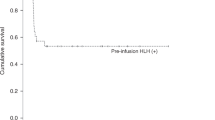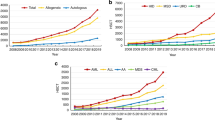Abstract
Management of rare hematological disorders pose unique diagnostic and therapeutic challenges due to unusual occurrence and limited treatment options. We retrospectively identified 45 patients receiving matched related donor transplant for rare hematological disorders from 2006 to 2019. Patients were divided into two groups (1) malignant and (2) non malignant. The malignant disorder group included four patients while the nonmalignant group included 41 patients divided into immune dysregulation (n = 23), bone marrow failure (n = 10), metabolic (n = 5), and bleeding diathesis (n = 3). Twenty-six (57.8%) patients received myeloablative conditioning (MAC) and 16 (35.6%) received reduced intensity conditioning (RIC), while 3 (6.6%) patients with severe combined immunodeficiency received stem cell infusion alone without conditioning. The cumulative incidence (CI) of grade II–IV acute GVHD (aGVHD) was 39.1% (n = 18) and chronic GVHD (cGVHD) 15.2% (n = 7). There was no primary graft failure while CI of secondary graft failure was 9%. Overall survival (OS) and disease-free survival (DFS) was 82.2% and 77.8% respectively. Group wise OS was 75% in the malignant group, 82.6% in the immune dysregulation group, 80% in patients with metabolic disorders and bone marrow failure, while 100% in patients with bleeding diathesis. This retrospective analysis shows that hematopoietic stem cell transplant can be a feasible treatment option for rare hematological disorders.
This is a preview of subscription content, access via your institution
Access options
Subscribe to this journal
Receive 12 print issues and online access
$259.00 per year
only $21.58 per issue
Buy this article
- Purchase on Springer Link
- Instant access to full article PDF
Prices may be subject to local taxes which are calculated during checkout


Similar content being viewed by others
References
Richter T, Nestler-Parr S, Babela R, Khan ZM, Tesoro T, Molsen E, et al. Rare disease terminology and definitions—a systematic global review: report of the ISPOR rare disease special interest group. Value Health. 2015;18:906–14.
Hennekam R. Care for patients with ultra-rare disorders. Eur J Med Genet. 2011;54:220–4.
Grosse SD, James AH, Lloyd-Puryear MA, Atrash H. A public health framework for rare blood disorders. Am J Prev Med. 2011;41:319–23.
Kanate AS, Majhail NS, Savani BN, Bredeson C, Champlin RE, Crawford S, et al. Indications for hematopoietic cell transplantation and immune effector cell therapy: guidelines from the American Society for Transplantation and Cellular Therapy: guidelines for hematopoietic transplantation and cellular therapy. Biol Blood Marrow Transplant. 2020;26:1247–56.
De la Fuente J, Baruchel A, Biondi A, de Bont E, Dresse MF, Suttorp M, et al. Managing children with chronic myeloid leukaemia (CML) recommendations for the management of CML in children and young people up to the age of 18 years. Br J Haemtol. 2014;167:33–47.
Filipovich A. Hemophagocytic lymphohistiocytosis (HLH) and related disorders. Hematol Am Soc Hematol Educ Program. 2009;2009:127–31.
Henter JI, Horne A, Aricó M, Egeler RM, Filipovich AH, Imashuku S, et al. HLH‐2004: diagnostic and therapeutic guidelines for hemophagocytic lymphohistiocytosis. Pediatr Blood Cancer. 2007;48:124–31.
Reddy RR, Babu BM, Venkateshwaramma B, Hymavathi C. Silvery hair syndrome in two cousins: Chediak-Higashi syndrome vs. Griscelli syndrome, with rare associations. Int J Trichology. 2011;3:107.
Ménasché G, Pastural E, Feldmann J, Certain S, Ersoy F, Dupuis S, et al. Mutations in RAB27A cause Griscelli syndrome associated with haemophagocytic syndrome. Nat Genet. 2000;25:173–6.
Shearer WT, Dunn E, Notarangelo LD, Dvorak CC, Puck JM, Logan BR, et al. Establishing diagnostic criteria for SCID, leaky SCID, and Omenn syndrome: the primary immune deficiency treatment consortium experience. J Allergy Clin Immunol. 2014;133:1092.
Bonilla FA, Khan DA, Ballas ZK, Chinen J, Frank MM, Hsu JT, et al. Practice parameter for the diagnosis and management of primary immunodeficiency. J Allergy Clin Immunol. 2015;136:1186–205.
Segal BH, Veys P, Malech H, Cowan MJ. Chronic granulomatous disease: lessons from a rare disorder. Biol Blood Marrow Transplant. 2011;17:S123–31.
Lipton JM, Ellis SR. Diamond-Blackfan anemia: diagnosis, treatment, and molecular pathogenesis. Hematol Oncol Clin N Am. 2009;23:261–82.
Heimpel H, Anselstetter V, Chrobak L, Denecke J, Einsiedler B, Gallmeier K, et al. Congenital dyserythropoietic anemia type II: epidemiology, clinical appearance, and prognosis based on long-term observation. Blood. 2003;102:4576–81.
Benichou O, Laredo J, De Vernejoul MJB. Type II autosomal dominant osteopetrosis (Albers-Schönberg disease): clinical and radiological manifestations in 42 patients. Bone. 2000;26:87–93.
Tolar J, Teitelbaum SL, Orchard P. Osteopetrosis. N Engl J Med. 2004;351:2839–49.
White JG, Nichols WL, Steensma D. Platelet pathology in sex-linked GATA-1 dyserythropoietic macrothrombocytopenia I ultrastructure. Platelets. 2007;18:273–83.
Mehaffey MG, Newton AL, Gandhi MJ, Crossley M, Drachman JGJB. X-linked thrombocytopenia caused by a novel mutation of GATA-1. Blood. 2001;98:2681–8.
French DL. The molecular genetics of Glanzmann’s thrombasthenia. Platelets. 1998;1:5–20.
Erwin A, Balwani M, Desnick RJ. Congenital erythropoietic porphyria. GeneReviews®. Seattle: University of Washington; 2016.
Scarpa M, Almássy Z, Beck M, Bodamer O, Bruce IA, De Meirleir L, et al. Mucopolysaccharidosis type II: European recommendations for the diagnosis and multidisciplinary management of a rare disease. Orphanet J Rare Dis. 2011;6:72.
Henter JI, Aricò M, Egeler RM, Elinder G, Favara BE, Filipovich AH, et al. HLH‐94: a treatment protocol for hemophagocytic lymphohistiocytosis. Med Pediatr Oncol. 1997;28:342–7.
Chan RJ, Cooper T, Kratz CP, Weiss B, Loh M. Juvenile myelomonocytic leukemia: a report from the 2nd International JMML Symposium. Leuk Res. 2009;33:355–62.
Cooper N, Rao K, Gilmour K, Hadad L, Adams S, Cale C, et al. Stem cell transplantation with reduced-intensity conditioning for hemophagocytic lymphohistiocytosis. Blood. 2006;107:1233–6.
Jones RJ, Lee K, Beschorner WE, Vogel VG, Grochow LB, Braine HG, et al. Venoocclusive disease of the liver following bone marrow transplantation. Transplantation. 1987;44:778–83.
Glucksberg H, Storb R, Fefer A, Buckner CD, Neiman PE, Clift RA, et al. Clinical manifestations of graft-versus-host disease in human recipients of marrow from HLA-matched Sibling donors. Tansplantation. 1974;18:295–304.
Shulman HM, Cardona DM, Greenson JK, Hingorani S, Horn T, Huber E, et al. NIH Consensus development project on criteria for clinical trials in chronic graft-versus-host disease: II. The 2014 Pathology Working Group Report. Biol Blood Marrow Transplant. 2015;21:589–603.
Pai S-Y, Logan BR, Griffith LM, Buckley RH, Parrott RE, Dvorak CC, et al. Transplantation outcomes for severe combined immunodeficiency, 2000–2009. N Engl J Med. 2014;371:434–46.
Mehta RS, Smith RE. Hemophagocytic lymphohistiocytosis (HLH): a review of literature. Med Oncol. 2013;30:740.
Messina C, Zecca M, Fagioli F, Rovelli A, Giardino S, Merli P, et al. Outcomes of children with hemophagocytic lymphohistiocytosis given allogeneic hematopoietic stem cell transplantation in Italy. Front Pediatr. 2018;24:1223–31.
Allen CE, Marsh R, Dawson P, Bollard CM, Shenoy S, Roehrs P, et al. Reduced-intensity conditioning for hematopoietic cell transplant for HLH and primary immune deficiencies. Blood. 2018;132:1438–51.
Lipton JM, Atsidaftos E, Zyskind I, Vlachos AJ. Improving clinical care and elucidating the pathophysiology of Diamond Blackfan anemia: an update from the Diamond Blackfan Anemia Registry. Pediatr Blood Cancer. 2006;46:558–64.
Myers KC, Davies S. Hematopoietic stem cell transplantation for bone marrow failure syndromes in children. Biol Blood Marrow Transplant. 2009;15:279–92.
Ishii E. Hemophagocytic lymphohistiocytosis in children: pathogenesis and treatment. Front Pediatr. 2016;4:47.
Quigg TC, McDonald L, Luke J, Chan KW, Jude VH, Sanders R. Allogeneic hematopoietic stem cell transplantation (HSCT) outcomes for juvenile myelomonocytic leukemia (JMML), a 15-year single center experience. Biol Blood Marrow Transplant. 2014;20:S180.
Marsh RA, Kim M-O, Liu C, Bellman D, Hart L, Grimley M, et al. An intermediate alemtuzumab schedule reduces the incidence of mixed chimerism following reduced-intensity conditioning hematopoietic cell transplantation for hemophagocytic lymphohistiocytosis. Biol Blood Marrow Transplant. 2013;19:1625–31.
Manabe A, Okamura J, Yumura-Yagi K, Akiyama Y, Sako M, Uchiyama H, et al. Allogeneic hematopoietic stem cell transplantation for 27 children with juvenile myelomonocytic leukemia diagnosed based on the criteria of the International JMML Working Group. Leukemia. 2002;16:645–9.
Korthof ET, Snijder PP, de Graaff AA, Lankester AC, Bredius RGM, Ball LM, et al. Allogeneic bone marrow transplantation for juvenile myelomonocytic leukemia: a single center experience of 23 patients. Bone Marrow Transplant. 2005;35:455–61.
Locatelli F, Nöllke P, Zecca M, Korthof E, Lanino E, Peters C, et al. Hematopoietic stem cell transplantation (HSCT) in children with juvenile myelomonocytic leukemia (JMML): results of the EWOG-MDS/EBMT trial. Blood. 2005;105:410–9.
Lehmberg K, Moshous D, Booth C. Haematopoietic stem cell transplantation for primary haemophagocytic lymphohistiocytosis. Front Pediatr. 2019;7:435.
Ouachée-Chardin M, Elie C, de Saint Basile G, Le Deist F, Mahlaoui N, Picard C, et al. Hematopoietic stem cell transplantation in hemophagocytic lymphohistiocytosis: a single-center report of 48 patients. Pediatrics. 2006;117:743–50.
Halkes C, de Wreede LC, Knol C, Simand C, Aljurf M, Tbakhi A, et al. Allogeneic stem cell transplantation for acquired pure red cell aplasia. Am J Hematol. 2019;94:294–6.
Porta F, Forino C, De Martiis D, Soncini E, Notarangelo L, Tettoni K, et al. Stem cell transplantation for primary immunodeficiencies. World Allergy Organ J. 2008;41:83–6.
Wijnaendts L, Le Deist F, Griscelli C, Fischer A. Development of immunologic functions after bone marrow transplantation in 33 patients with severe combined immunodeficiency. Blood.1989;74:2212–9.
Müller B, Tichelli A, Passweg J, Nissen C, Wodnar-Filipowicz A, Gratwohl AJ. Successful treatment of refractory acquired pure red cell aplasia (PRCA) by allogeneic bone marrow transplantation. Case Rep Oncol. 1999;23:1205–7.
Haddad E, Logan BR, Griffith LM, Buckley RH, Parrott RE, Prockop SE, et al. SCID genotype and 6-month posttransplant CD4 count predict survival and immune recovery. Blood. 2018;132:1737–49.
Author information
Authors and Affiliations
Corresponding author
Ethics declarations
Conflict of interest
The authors declare that they have no conflict of interest.
Additional information
Publisher’s note Springer Nature remains neutral with regard to jurisdictional claims in published maps and institutional affiliations.
Rights and permissions
About this article
Cite this article
Khan, M., Iftikhar, R., Ghafoor, T. et al. Allogeneic hematopoietic stem cell transplant in rare hematologic disorders: a single center experience from Pakistan. Bone Marrow Transplant 56, 863–872 (2021). https://doi.org/10.1038/s41409-020-01126-4
Received:
Revised:
Accepted:
Published:
Issue Date:
DOI: https://doi.org/10.1038/s41409-020-01126-4



